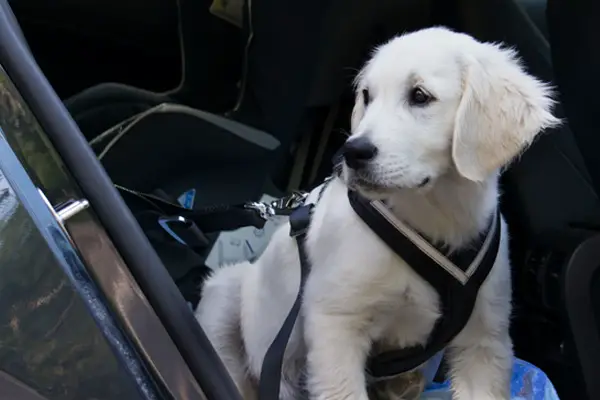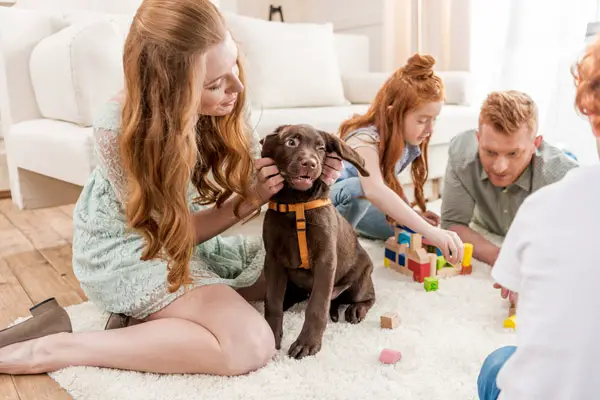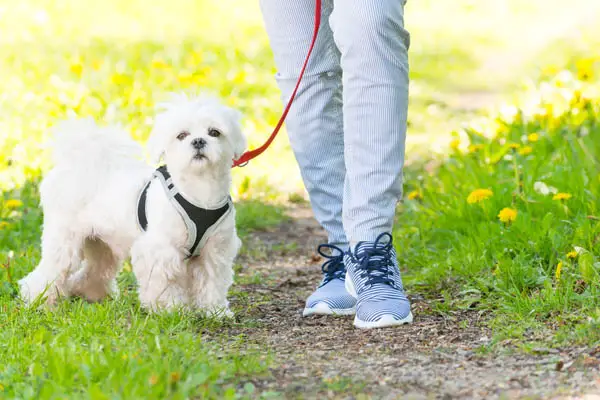
Most people get dogs that are at eight weeks of age. You can begin basic training during that time, including leash walking. Many handlers ask questions line “Should I get a collar or harness for puppy?” or “What age can you put a harness on a puppy?” In reality, both have their benefits but harnesses come with many additional features that dog collars may not offer. Also, puppies can wear a harness as early as when you get them at eight weeks old.
Some veterinarians, however, recommend that you do not start training until after your pup receives his or her last vaccination booster shot. This happens when your pup is around 14 to 16 weeks old. This is to prevent your pet from getting sick with diseases like canine flu he or she might get from being exposed to airborne viruses.
It is also best that you give your puppy some time to adjust to his or her new home for a few days before you begin training. This way, your new pet can also get accustomed to you and vice versa. This will help make the puppy harness training process easier for both of you.
How To Find The Best Puppy Harness
Finding a harness that will fit well to your puppy’s growing body can be challenging. Fortunately, there are a few features pet parents can look into to make shopping for a harness easier. But before you begin shopping, don’t forget to measure your puppy for a harness. If you find that your pup is in between sizes, then choose the harness that is a size larger since your puppy will grow bigger as the months pass by.
The harness should also be adjustable. This way, you can adjust the fit of the harness as your puppy grows larger. The harness should also be made of chew-proof material. This is vital, especially if your puppy is teething or likes to chew on things. And even the most well-behaved pup can gnaw on the front section of the harness when you aren’t looking. A chew-proof harness will prevent you from repeatedly buying a new one every time your pup chews through it.
You should also make sure that the harness you purchase is durable but affordable. Your puppy will eventually grow out of his or her first harness, and you’ll need to buy a new one. Therefore, affordability is a great feature. Before you go out and buy the best small dog harness, make sure you find an adjustable harness for growing puppies.
Harness Training For Puppies
Puppies are often easier to train than an adult dog. A dog that has reached his or her full size may take longer to learn new skills. Therefore, here are a few harness training tips to help you with training your puppy:

Familiarize Your Pup With The Harness
Let your dog investigate the harness. Leave it on an area where they are the most and let them sniff it or play with it so they can become comfortable with it. Once your pup becomes familiar with the harness, buckle it in and let your pup wear it around the house with or without a leash. You can even go for a quick walk around your yard or to another room in the house.
However, if your pup panics or tries to get away after you snap in the harness, then remove it immediately. You would not want to associate the harness as something your pup fears. Otherwise, you’d soon find the harness in threads because your puppy saw it as an enemy that needed to be destroyed.
Go On A Walk
Walk your pup in an area that he or she is familiar with and comfortable in. This way, your pet is less likely to be upset. Also, try and consistently lead them with either your right or left arm. This sets an expectation to your puppy on how to behave in the future.

Use Positive Reinforcement
Dogs of any age are mainly motivated by positive reinforcement. Place treats on the harness and let your pup eat off of it. Aside from food, you can also place your pup’s favorite toys around the harness so that they know it is not something he or she should be afraid of.
Another thing to try is to praise your dog whenever he or she touches the harness. Make sure you use a cheery voice whenever you are preparing to snap on the harness to your dog as well. This way, your pup will know that walking with the harness is a fun and important event.
Conclusion
A harness isn’t bad for puppies, as it is one of the best ways you can train your canine friend and keep him or her securely attached to you. It helps prevent your pup from getting tangled with the leash, which can end up injuring your dog. A harness also keeps active puppies from pulling on the leash, which reduces the possibility of neck injuries. You can also find a cute puppy harness that is comfortable too. Many have reflective features to help you and your new pup stay safe while walking in the dark.
